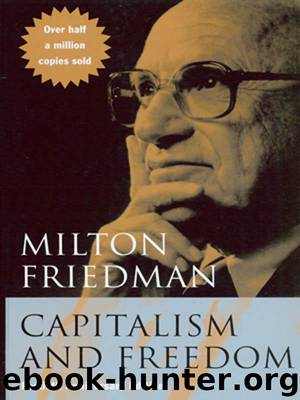Capitalism and Freedom: Fortieth Anniversary Edition by Friedman Milton & Friedman Rose D

Author:Friedman, Milton & Friedman, Rose D. [Friedman, Milton]
Language: eng
Format: mobi
Publisher: University of Chicago Press
Published: 2009-02-15T05:00:00+00:00
1 It is by no means so fantastic as may appear that such a step would noticeably affect the size of families. For example, one explanation of the lower birth rate among higher than among lower socio-economic groups may ell be that children are relatively more expensive to the former, thanks in considerable measure to the higher standards of schooling they maintain, the costs of which they bear.
2 A striking example of the same effect in another field is the British National Health Service. In, a careful and penetrating study, D. S. Lees establishes rather conclusively that, “Far from being extravagant, expenditure on NHS has been less than consumers would probably have chosen to spend in a free market. The record of hospital building in particular has been deplorable.” “Health Through Choice,” Hobart Paper 14 (London: Institute of Economic Affairs, 1961), p. 58.
3 See George J. Stigler, Employment and Compensation in Education (“Occasional Paper” No. 33, [New York: National Bureau of Economic Research, 1950]), p. 33.
4 I am abstracting from expenditures on basic research. I have interpreted schooling narrowly so as to exclude considerations that would open up an unduly wide field.
5 I have used Ohio rather than Illinois, because since the article of which this chapter is a revision was written (1953), Illinois has adopted a program going part-way along this line by providing scholarships tenable at private colleges and universities in Illinois. California has done the same. Virginia has adopted a similar program at lower levels for a very different reason, to avoid racial integration. The Virginia case is discussed in chapter vii.
6 The increased return may be only partly in a monetary form; it may also consist of non-pecuniary advantages attached to the occupation for which the vocational training fits the individual. Similarly, the occupation may have non-pecuniary disadvantages, which would have to be reckoned among the costs of the investment.
7 For a more detailed and precise statement of the considerations entering into the choice of an occupation, see Milton Friedman and Simon Kuznets, Income from Independent Professional Practice (New York: National Bureau of Economic Research, 1945), pp. 81–95, 118–37.
8 See G. S. Becker, “Underinvestment in College Education?” American Economic Review, Proceedings L (1960), 356–64; T. W. Schultz, “Investment in human Capital,” American Economic Review, LXI (1961), 1–17.
9 Despite these obstacles to fixed money loans, I am told that they have been a very common means of financing education in Sweden, where they have apparently been available at moderate rates of interest. Presumably a proximate explanation is a smaller dispersion of income among university graduates than in the United States. But this is no ultimate explanation and may not be the only or major reason for the difference in practice. Further study of Swedish and similar experience is highly desirable to test whether the reasons given above are adequate to explain the absence in the United States and other countries of a highly developed market in loans to finance vocational education, or whether there may not be other obstacles that could be removed more easily.
Download
This site does not store any files on its server. We only index and link to content provided by other sites. Please contact the content providers to delete copyright contents if any and email us, we'll remove relevant links or contents immediately.
International Integration of the Brazilian Economy by Elias C. Grivoyannis(98609)
The Radium Girls by Kate Moore(11970)
Turbulence by E. J. Noyes(7977)
Nudge - Improving Decisions about Health, Wealth, and Happiness by Thaler Sunstein(7655)
The Black Swan by Nassim Nicholas Taleb(7054)
Rich Dad Poor Dad by Robert T. Kiyosaki(6506)
Pioneering Portfolio Management by David F. Swensen(6253)
Man-made Catastrophes and Risk Information Concealment by Dmitry Chernov & Didier Sornette(5951)
Zero to One by Peter Thiel(5729)
Secrecy World by Jake Bernstein(4698)
Millionaire: The Philanderer, Gambler, and Duelist Who Invented Modern Finance by Janet Gleeson(4417)
The Age of Surveillance Capitalism by Shoshana Zuboff(4243)
Skin in the Game by Nassim Nicholas Taleb(4200)
Bullshit Jobs by David Graeber(4137)
The Money Culture by Michael Lewis(4130)
Skin in the Game: Hidden Asymmetries in Daily Life by Nassim Nicholas Taleb(3960)
The Dhandho Investor by Mohnish Pabrai(3721)
The Wisdom of Finance by Mihir Desai(3693)
Blockchain Basics by Daniel Drescher(3537)
